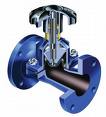You are here:
News >
News Detail
The development of diaphragm valve
2012-06-28
A diaphragm VALVE is a shutoff or control valve with a flexible
membrane, or diaphragm, which seals the valve completely or partially
once the valve is engaged. Once the actuator is engaged, a stem within
the valve pushes a plug or compressor against the diaphragm. The
diaphragm is pushed against a raised section of the valve, creating a
seal. This seal stops the flow of liquid, gas or other material through
the valve. Diaphragm valves are able to seal more tightly than other
types of valves due to their flexible membrane.
The diaphragm valve traces its origins back to the ancient Roman and
Greek times, where it was used to control the water and temperature of
the hot baths. With a crude leather diaphragm, which was manually closed
over a weir, it was a primitive but effective control valve. 
In the early 1900s, a South African mining engineer by the name of
P. K. Saunders was charged with the project to cut the costly power
losses due to faulty, leaking seats and stuffing boxes of the valves
used to supply air and water in the underground mines. Saunders was
interested in ancient history and archaeology as a hobby, and stumbled
upon the use of the control valves used in the baths. He utilized this
concept to develop the first modern diaphragm valve.
Originally, the diaphragm valve was developed for use in
non-hygienic applications. Later on the design was adapted for use in
the bio-pharmaceutical industry by using compliant materials that can
withstand sanitizing and sterilizing methods.
Diaphragm valves (or membrane valves) consists of a valve body with
two or more ports, a diaphragm, and a "saddle" or seat upon which the
diaphragm closes the valve. The valve is constructed from either plastic
or steel.
Diaphragm valves are available in two basic forms: weir type and
straight through types. The weir design is best for general use
applications or for tough corrosive and abrasive services. The straight
through type can be used in situations where the flow direction changes
within the system. They are excellent for use with sludge, slurries and
other viscous fluids. Both styles provide a streamlined path for fluid
flow that yields minimal pressure drop across the valve. In addition to
the well known, two way shut off diaphragm valve, other types include:
three way zero dead leg valve, sterile access port, block and bleed, Val
bow and tank bottom valve just to name a few.
The advantages provided by diaphragm valves are many. They are
extremely clean, and can form a nearly leak-proof seal for tight
shut-off. The diaphragm design provides for easy maintenance and repair
as it can be replaced without disturbing the piping line. However, they
are limited they are limited to moderate temperature (-60 to 450

